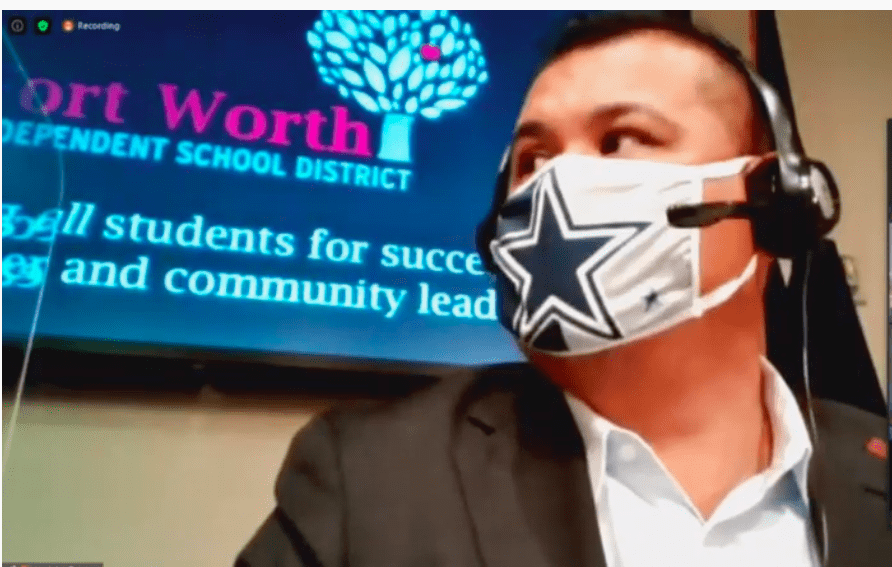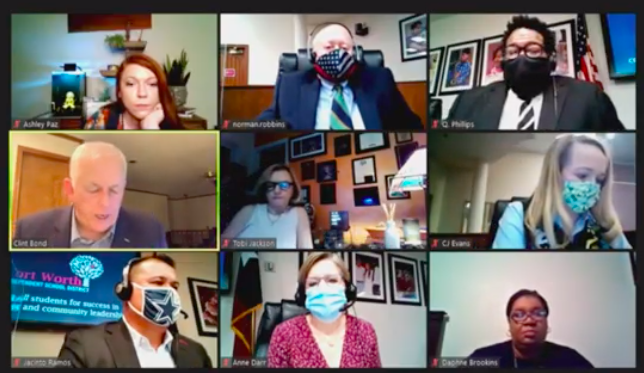Parents and teachers fed up with the Fort Worth school board’s flip-flopping finally got an answer for when families will have a choice to send their kids back to school for in-person learning, after weeks of being limited to online “virtual” instruction due to coronavirus concerns.
Fort Worth Independent School District is required by the Texas Education Agency to resume some level of on-campus instruction on October 5, offering students the option to attend in-person or virtually.
In a marathon meeting that started at 5:30 p.m. Tuesday and lasted until 4:00 a.m. Wednesday morning, school board trustees voted 5-4 to seek a TEA waiver extending the district’s back-to-school transition, allowing administrators to stagger students’ return to campuses over a two-week period starting on October 5.
Trustees reached the compromise after rejecting motions to fully reopen campuses on October 5 as planned or to extend the staggered back-to-school plan for four weeks—a proposal rejected 5-4 at last week’s school board meeting.
“We need to give families the choice to weigh all the consequences and decide what is best for them,” a parent told board members Tuesday. “We are struggling.”
The board also voted 8-1 to adopt a hybrid model for high school instruction, which also requires a TEA waiver. Students in grades 9-12 who choose in-person learning will be divided into two groups and attend classes on different days.
Deputy Superintendent Karen Molinar explained that the waiver does not mean the district can remain completely virtual for additional weeks:
“You have to have on-campus instruction provided each day. Regardless of additional weeks, you do have to have instruction start on your campus on the fifth week. For us, that’s October 5.
“I think there was some miscommunication with that, and I heard it tonight in our public comments.”
After a couple of false starts, the district set the start of the school year for September 8, with virtual-only learning.
Frustration with district officials’ handling of back-to-school plans and the board’s lack of clear communication was evident during the four hours of public comments at the start of Tuesday’s meeting, from nearly 200 citizens on both sides of the issue.
For families that requested in-person learning for their kids—about half of Fort Worth ISD’s 84,000 students, according to Molinar—any delay is disappointing.
“Give parents a chance to put our kids back in the classroom,” said educator and mom of three Joy Blocker, who spoke on behalf of many parents wanting a choice for their children.
A petition Blocker started urging school board members to start in-person learning as quickly as possible drew over 3,000 signatures by the time of Tuesday’s meeting.
Working parents with multiple children shared their struggles to monitor their children’s online schoolwork, while others said they experienced frequent technical glitches or didn’t even have a computer or hotspot needed to access virtual classes. Many said online learning simply isn’t working for their kids and, in fact, is hurting them.
“My kid can’t learn virtually. I cant even tell how far behind he is now,” one working mom told the board. “I can’t support my family if I’m supposed to stay home as their teacher.”
“There is a cost to not being in the classroom, and it goes beyond academics,” said another parent.
“I don’t think the mental health toll virtual learning is taking on families can be overstated,” added another.
Several were concerned the district is losing students to private schools; others said they had moved their own kids out of district schools in order to access in-person learning.
A number of teachers joined parents in calling for a quick return to classrooms, citing the detrimental effects on students’ skills and mental state caused by not having face-to-face learning.
Other teachers, who are all required to report to campus on September 28, said the two-week delay was too short. They say the district has not shown them an adequate plan for returning safely.
Some wanted to delay all in-person instruction for at least four weeks—or indefinitely—citing health risks. But that wasn’t an option.
A few citizens called out Board President Cinto Ramos Jr.—who voted multiple times to keep kids out of schools for as long as possible, claiming it isn’t safe—for taking his son to Sunday’s Dallas Cowboys football game with over 20,000 fans in the stadium. Ramos wore a Cowboys face mask during Tuesday’s board meeting.
 Some cited the Tarrant County Public Health Department’s School Re-Opening Dashboard, updated each Monday, which this week recommended virtual learning for all students in the county, based on two benchmarks: an upward trend in “COVID-like” illnesses and an 11 percent test positivity rate.
Some cited the Tarrant County Public Health Department’s School Re-Opening Dashboard, updated each Monday, which this week recommended virtual learning for all students in the county, based on two benchmarks: an upward trend in “COVID-like” illnesses and an 11 percent test positivity rate.
Others referenced an open letter published Monday by Fort Worth Mayor Betsy Price, Cook Children’s Health Care System, and several business and community leaders, urging trustees to stick by their decision to offer families the choice of in-school instruction starting October 5.
Their letter echoed concerns of other officials, teachers, and parents about how students are suffering from being out of the classroom for months:
“It is no secret that school closures pose their own threats to our children, from increases in child abuse, food insecurity, and negative academic outcomes. … The current instability in leadership is pitting parents against teachers and attempting to divide our community.”
“We believe the best place for a child to learn is in the classroom with a teacher,” Fort Worth ISD Superintendent Kent Scribner said in July, a day before the district’s original August 17 school year start was postponed.
“We expect to see historic academic regression,” Scribner added after the district’s first school shutdown plan was announced. “Students have not been in class since March 6 in Fort Worth, Texas.”
After seven months, Fort Worth families will finally have a choice to change that.





